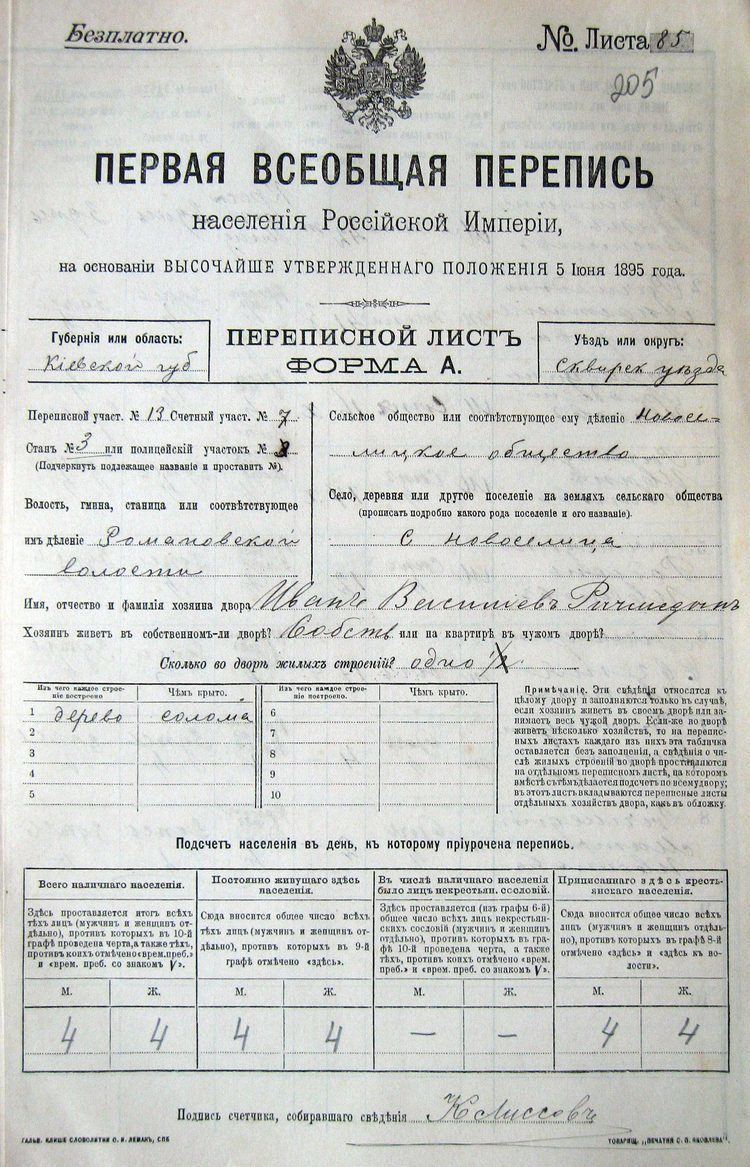Start date January 28, 1897 | ||
 | ||
Russian empire census
The Russian Imperial Census of 1897 was the first and the only census carried out in the Russian Empire (Finland was excluded). It recorded demographic data as of 28 January [O.S. 15 January] 1897.
Contents
- Russian empire census
- Organization
- Census results
- By native tongue
- Population by modern day countries
- Largest cities
- Assessment
- References
Previously, the Central Statistical Bureau issued statistical tables based on fiscal lists (ревизские списки).
The second Russian Census was scheduled for December 1915, but was cancelled because of the outbreak of World War I one and a half years earlier (in July 1914). It was not rescheduled before the Russian Revolution. The next census to take place in Russia only occurred at the end of 1926, almost three decades later.
Organization
The census project was suggested in 1877 by Pyotr Semenov-Tyan-Shansky, a famous Russian geographer and chief of the Central Statistical Bureau, and was approved by Tsar Nicholas II in 1895.
The census was performed in two stages. In the first stage (December 1896 — January 1897) the counters (135,000 persons: teachers, priests, and literate soldiers) visited all households and filled in the questionnaires, which were verified by local census managers. In the second stage. (9 January 1898 [O.S. 28 December 1897]) the counters simultaneously visited all households to verify and update the questionnaires. Despite this being the only census they ever took, Historians were able to find out the Russian Empires population in earlier periods of time still from collecting city censuses.
The data processing took 8 years using Hollerith card machines. Publication of the results started in 1898 and ended in 1905. In total, 119 volumes for 89 guberniyas, as well as a two-volume summary, were issued.
The questionnaire contained the following questions:
In the census summary tables, nationality was based on the declared mother language of respondents.
Census results
The results of the census are too broad to publish.
The total population of the Russian Empire was recorded to be 125,640,021 people (50.2% female, 49.8% male; urban 16,828,395 ).
By native tongue
The most spoken languages, from which nationality was determined were:
Population by modern day countries
Largest cities
Largest cities of the Empire according to the census:
Assessment
As in many other census in the era of nationalism, the results reflect the views on national policy of the authorities. In this case, the population of Russian ethnicity was inflated. Thus for example, the number of Poles is underrepresented. Imperial officials classified the Ukrainian and Belarusian languages as belonging to Russian group and labeled those nationalities as Little Russian for Ukrainians and White Russian for Belarusians.
